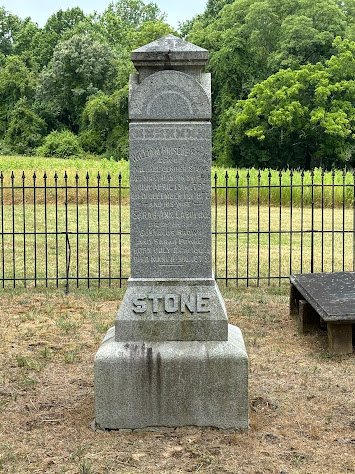In our quest to visit the graves of the signers of the Declaration of Independence, we traveled to the former home of Thomas Stone.
Thomas Stone (1743-October 5, 1787) was an American Founding Father, politician and lawyer who signed the Declaration of Independence as a delegate for Maryland. He later worked on the committee that formed the Articles of Confederation in 1777. He acted as president of Congress for a short time in 1784 and was a member of the Maryland Senate from 1777-1780 and again from 1781-1787.
This was an unexpected surprise. We knew there was a visitor center but really had no idea it would be anything like this.
We went inside the Visitor Center and spent some time with a guide who loved to tell us more about Thomas Stone than we probably ever wanted to know. That man knows his stuff!
From there we headed to the back of the property to see the burial ground and tour the home.
We met another guide who told us the history of the home and how it's changed over the years.
Many visitors are curious about the site's historic name "Haberdeventure" and some have noticed a few different spellings. Some have stated that the National Park Service should use "Habre de Venture," the spelling used by the last owners of the home.
Examination of three centuries of historic records has shown that the residents of the site have spelled the name in a variety of ways. The first known use of the name was "Habberdeventure" when the land was surveyed and developed by the family of John Barefoot in 1682. Thomas Stone spelled it "Haberdeventure" while the last owners preferred "Habre de Venture."
As far as the meaning of Haberdeventure, it is generally accepted that the name is a loose variation of the Latin phrase of "havitatio de ventus" which means to "dwell in or of the wind."
This 1902 photograph of the south facade, the earliest known photograph of the exterior, shows the house as it would have appeared about 1870. By that time an ornate design of woodwork replaced the original porch trim and columns.
Thomas Stone purchased Haberdeventure in 1770 and began construction of a new home in 1771. The original plan was to build a small, modest home for him, his wife Margaret, and their two daughters but before the house was completed, his father died and five of his younger brothers and sisters came to live with him creating the need for a larger home. During the 1780s, the plantation probably supported about 25 to 35 people, including a number of slaves. By the time of Stone's death in 1787, the property had increased in size from 442 acres to 1,077 acres.
The house is furnished beautifully, although nearly every item is not original to the home.
The writing desk is the only original item in the house.
The same year that Stone was assigned to the committee that drafted the Articles of Confederation, his wife, Margaret, visited him in Philadelphia which was in the midst of a smallpox epidemic. She was vaccinated for the disease, but an adverse reaction to the treatment made her ill. Her health continued to decline for the rest of her life. After Stone signed the Declaration of Independence, he took his wife home and declined future appointment to the Congress, except for part of 1784 when the meetings were in Annapolis.
As his wife's health continued to decline, he gradually withdrew from public life. When Margaret died at the age of 36 in 1787, he became depressed and died less than four months later at the age of 43-44, reportedly of a "broken heart."
Margaret and Thomas Stone
Descendants of Thomas Stone continued to own Haberdeventure until 1936 when the land was sold. The property was privately owned until 1977 when a fire severely damaged the central section of the house. The Vischer family, who owned the house, did not reoccupy it.
Haberdeventure was authorized as a National Historic Site a year later in 1978 and was purchased by the National Park Service in 1981. Restoration efforts on the historic structures began at that time but the house was not opened to the public until 1997.
A short walk from the house is the graveyard, where Thomas is buried alongside his wife and other family members.
I'm so happy we were able to make this visit - it was wonderful!






















No comments:
Post a Comment